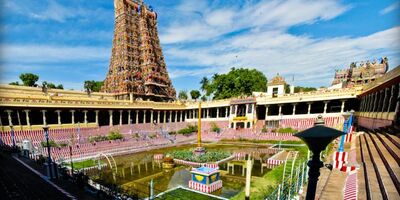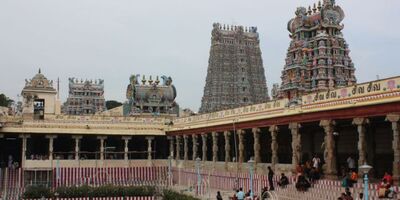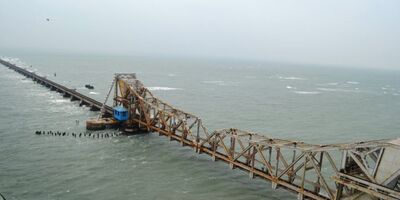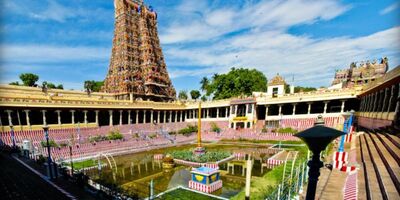Meenakshi Temple , Madurai
About Meenakshi Temple
Dedicated to goddess Goddess Parvati (Meenakshi) and her husband Lord Shiva, many visit Mudarai just to see Meenakshi Amman Temple. There are four towers or 'Gopurams' that taper inwards toward the sky. Each tower is decorated with a thousand painted sculptures. Baskets of coconuts, bananas and incense are available to buy. Devotees line up to perform darshan. Non- Hindus are not allowed in the inner sanctum. Meenakshi temple is spread over 16 acres and you can hire a guide if you have an architectural inclination, but beware of ‘guides’ who try to lure you into nearby shops.
There is a market of flowers, spices and handicrafts surrounding the temple. Best time to visit the temple is in the mornings. Main attraction of the temple are its golden lotus pond, long corridors inside the temple and gopurams, temple museum and the thousand pillar hall.
The Madurai Meenakshi Temple, located in the heart of Madurai in Tamil Nadu, is one of the most iconic and revered Hindu temples in India. Known for its magnificent Dravidian architecture and vibrant cultural traditions, this ancient temple is dedicated to Goddess Meenakshi (a form of Parvati) and her consort, Sundareshwar (Shiva). This guide provides an in-depth look at the temple’s history, architectural features, and visitor information.
Overview of Madurai Meenakshi Temple
- Location: Madurai, Tamil Nadu, India
- Deity: Goddess Meenakshi and Lord Sundareshwar
- Architectural Style: Dravidian
- Significance: Major pilgrimage site and cultural landmark
Historical Significance
- Ancient Origins: The Madurai Meenakshi Temple has a rich history dating back over 2,500 years. The temple complex was extensively renovated and expanded during the reign of the Pandya kings, particularly during the 16th century.
- Legend and Mythology: According to legend, Goddess Meenakshi was born with three breasts, which disappeared upon meeting her future husband, Sundareshwar. The temple’s mythology is deeply embedded in South Indian culture and religious practices.
Architectural Marvel
1. Temple Complex
- Gopurams (Gateway Towers): The temple is renowned for its towering gopurams, each richly adorned with intricate sculptures and vibrant colors. There are four main gopurams, each representing different directions.
- Sanctum Sanctorum: The inner sanctum houses the main deities, Meenakshi and Sundareshwar. The sanctum is surrounded by pillared halls and smaller shrines dedicated to various deities.
2. Notable Structures
- Hall of a Thousand Pillars: This impressive hall is known for its beautifully carved pillars, each depicting different mythological scenes and figures. It is a prime example of Dravidian architectural expertise.
- Temple Tanks: The complex includes two large temple tanks (ponds), the Pottramarai Tank and the Meenakshi Tank, which are used for religious rituals and ceremonies.
3. Art and Sculptures
- Sculptural Detail: The temple’s walls and pillars are adorned with thousands of sculptures depicting Hindu gods, goddesses, and mythical creatures. The artistry reflects the skilled craftsmanship of ancient Tamil artisans.
- Colorful Frescoes: Vibrant frescoes and paintings cover the ceilings and walls of the temple, illustrating various Hindu epics and religious stories.
Visitor Experience
1. Rituals and Festivals
- Daily Poojas: The temple conducts several daily rituals and poojas (prayers), which attract large crowds of devotees. The most prominent pooja is the evening ritual, where the deities are carried in a grand procession.
- Festivals: Major festivals celebrated at the temple include Meenakshi Thirukalyanam (the divine marriage of Meenakshi and Sundareshwar), Chithirai Festival, and Vasanthotsavam.
2. Cultural Significance
- Cultural Hub: The temple is a center of cultural activities, including classical music and dance performances. Traditional South Indian art forms are often showcased during festivals and special events.
- Pilgrimage: The temple is a significant pilgrimage site for Hindus from across India and abroad, who visit to seek blessings and participate in religious ceremonies.
Visitor Information
- Timings: The temple is open daily from 5:00 AM to 12:30 PM and from 4:00 PM to 10:00 PM. Specific timings may vary during festivals and special occasions.
- Entry Fee: There is no entry fee to visit the temple. However, donations are welcomed to support temple activities and maintenance.
- Dress Code: Visitors are expected to dress modestly. Traditional attire such as sarees or dhotis is recommended. Footwear must be removed before entering the temple premises.
- Facilities: Basic facilities such as restrooms, cloakrooms, and food stalls are available. Visitors can also find shops selling religious items and souvenirs around the temple area.
Nearby Attractions
- Thirumalai Nayakkar Palace: Located about 2 kilometers from the temple, this historic palace showcases Indo-Saracenic architecture and was once the residence of the Nayak kings.
- Gandhi Memorial Museum: Approximately 1.5 kilometers from the temple, this museum is dedicated to Mahatma Gandhi and features exhibits on the Indian freedom struggle.
Tips for Visitors
- Best Time to Visit: The best time to visit the Madurai Meenakshi Temple is during the cooler months from October to March. Early mornings and late afternoons offer a more peaceful experience.
- Photography: Photography is generally not allowed inside the inner sanctum of the temple. However, visitors can capture the exterior and architectural details of the temple.
- Respect Local Customs: Adhere to local customs and guidelines, particularly regarding dress code and behavior. Maintain cleanliness and respect the religious practices of the temple.
Frequently Asked Questions (FAQs)
1. What is the significance of the Madurai Meenakshi Temple?
- The Madurai Meenakshi Temple is a major Hindu pilgrimage site dedicated to Goddess Meenakshi and Lord Sundareshwar. It is renowned for its Dravidian architecture and rich cultural heritage.
2. What are the main features of the Madurai Meenakshi Temple?
- Key features include the towering gopurams, the Hall of a Thousand Pillars, the temple tanks, and the intricate sculptures and frescoes.
3. Are there any entry fees for visiting the Madurai Meenakshi Temple?
- There is no entry fee to visit the temple, though donations are appreciated.
4. What facilities are available for visitors at the temple?
- Facilities include restrooms, cloakrooms, food stalls, and shops selling religious items and souvenirs.
5. What is the dress code for visiting the temple?
- Visitors are expected to dress modestly. Traditional attire such as sarees or dhotis is recommended. Footwear must be removed before entering the temple.
Conclusion
The Madurai Meenakshi Temple stands as a testament to the architectural brilliance and spiritual richness of Tamil Nadu. Its grand design, intricate artwork, and vibrant cultural traditions make it a must-visit destination for anyone exploring South India. Experience the grandeur and sacred ambiance of the Madurai Meenakshi Temple and immerse yourself in the profound heritage of this ancient landmark.
You wont be allowed inside the temple if you are wearing shorts.
Location & Places to Visit on Meenakshi Temple Map
View destinations and attractions nearby Meenakshi Temple, on an interactive map.
Freedom to make your own trip!
What you want, when you want and how you want.
































